Visits to Various Museums in Gothenburg: Notes on Sweden’s Approach to Art and Exhibitions, by Eduardo Navas
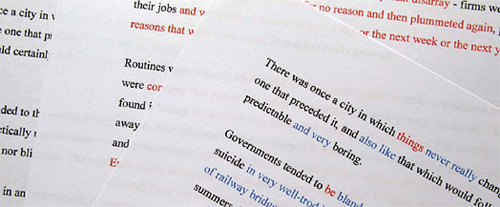
Image source: Göteborgs Konsthall
Tim Etchells (born 1962, lives and works in Great Britain)
City Changes (2008) inkjet prints
As part of my residency at the Swedish Traveling Exhibitions, I visited a number of museums in the City of Gothenburg. I was not alone in this trip. I travelled with Melissa Mboweni, a contemporary art curator from South Africa, who was also a Correspondent in Residence.
This entry includes brief notes on some of the places we visited while in Gothenburg. This is also the last entry of my travels in Sweden. Other details of my research will appear in longer texts to be published at a later date in the Swedish Traveling Exhibitions’ Spana magazine.
On the afternoon of November 9, our first stop was Gothenburg’s Art Museum (Göteborgs Konstmuseum), where we were greeted by Curator Johan Sjöström. We spent sometime with an exhibition he curated on Ivar Arosenius, a prolific nineteenth century artist. The exhibit features 250 works, which, as Sjöström explained, was a selection from a larger body of work. Arosenius was a Swedish artist who grew up in Älvängen, a small town north of Gothenburg. He died in January 2, 1909 at the age of thirty due to complications of Haemophilia. I was overwhelmed by the amount of pieces on display–as I realized that an entire day would not allow for anyone to view properly all of the works. Sjöström explained that Arosenius would at times produce several pieces in one night.
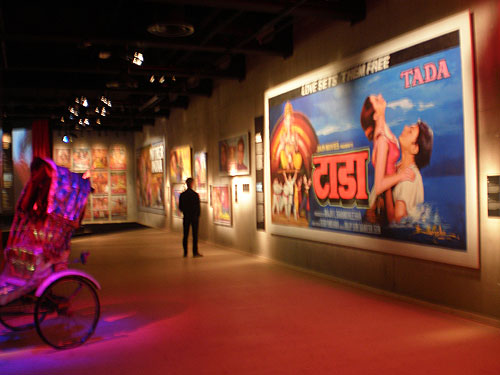
“Bollywood,” an exhibit on the film industry in India, at display at the Museum of World Culture until May of 2010.
The next day, November 10, we visited Världskulturmuseet (The Museum of World Culture). Our host was Cajsa Lagerkvist, Head of Exhibitions and Research. We spent the morning with a few of her colleagues discussing the museum’s mission. I realized that the institution was unlike any other I had visited up to this point, as it focuses on what Cajsa and her colleagues referred to as contemporary global issues. This premise is rather open ended, and gives the museum, in my view, quite a bit of freedom to develop exhibitions that are sensitive to the ever changing facets of globalization.
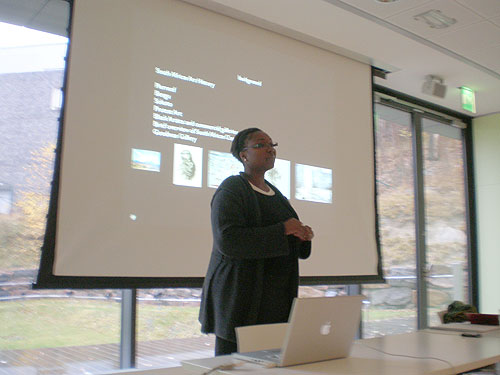
South African Curator, Melissa Mboweni, during her lecture at the Museum of World Culture
At the time of my visit they featured an exhibit on Vodou, and another on Bollywood. I was told by our hosts that last year the museum enjoyed 240,000 visits, and that many people who attend are younger than thirty. It became understandable why the Museum of World Culture emphasizes education as part of their mission. During that afternoon, Melissa Mboweni and I presented our research to curators of various museums in the city.
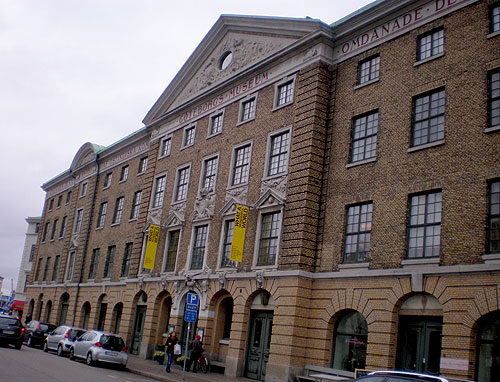
Facade of the City Museum of Gothenburg
On the morning of November 11, we visited the Stadsmuseet (City Museum of Gothenburg). Curator Christian Penalva and Project Manager Charlotta Dohlvik, along with three of their colleagues took us around the numerous galleries. The City Museum is in essence a hybrid of collections that fit well under the term cultural history. It holds a number of important archeological pieces from the Viking era as well as artifacts from the early days of trade in the eighteenth and nineteenth century; it also hosts an impressive collection of Swedish theatre and dance costumes.
The City Museum also supports contemporary activities. At the time of our visit, it featured selections of the Gothenburg Art Biennale, titled What a Wonderful World, curated by Celia prado and Johan Pousette. We had a very animated discussion as Penalva explained the museum’s interest in implementing innovative approaches to exhibiting. The museum is considering how the concept of interactivity as defined in new media practice can be beneficial to the development of future as well as already existing exhibitions.
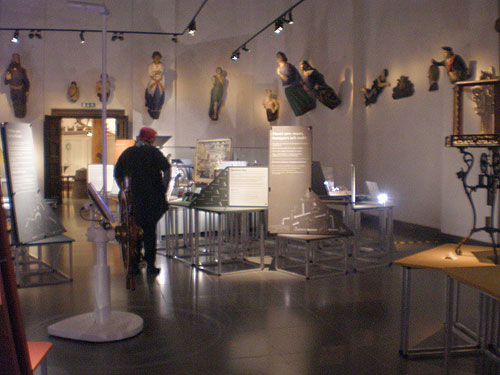
Main exhibition gallery at the Maritime Museum
During the afternoon we visited Sjöfartsmuseet (The Maritime Museum), where we were greeted by Curators Britta Söderqvist, Linda Noreen and their colleagues. They took us around the different exhibitions while explaining the special role of the museum in Gothenburg, which is important given that the Little London ( a popular reference) is a port city. Like the other museums, the Maritime Museum places an emphasis on youth education. Noreen, specifically, heads a project titled “Shoreline,” in which young citizens are encouraged to reflect through art, writing, and other creative forms of communication on what it means to live in a port city. Much of this activity is extended online.
A Virtual Aquarium display at the Maritime Museum. Direct camera feed from the ocean.
In general, the curators appear invested in exploring new forms of display. At the time, a historical exhibition of the port was on view. The idea was to present information and material in similar fashion as would be found in a working space. One display that caught my attention was a “virtual aquarium,” placed on one of the working tables (see video above). The aquarium actually is a camera feed from the sea presented on a large screen, also available online. Instead of viewing fish in a large container, the visitor can observe them in their natural environment and therefore get a sense of actual marine life.
Another place that we visited on the early evening of November 10 is Gothenburgs Konsthall, which is one of the venues hosting the Gothenburg Biennal. Curator Stina Edblom showed us around. There were quite a few good pieces in the exhibition, but I will only name one in this case, to be brief. I was particularly taken aback by Tim Echels’s “City Changes” (2008), [see image at the top of this entry]. The work consists of colored inkjet prints of a simple story about a small town. As the story is edited, the changes are recorded in different colors. Each draft is displayed in linear fashion from left to right across two gallery walls. Anyone who has a consistent relationship with writing will find Echels’s obvious–yet unexpected–focus on the act of editing quite refreshing.
Admittedly, since I struggle with ongoing edits of my own, I could not help but notice how meaning changed from one draft to the next; but I also wondered about edits that were between the drafts. Upon closer reflection, one could contemplate the possibility that the changes from one version to the next were deliberate to emphasize the flux in meaning as process, rather than trying to get a specific point across. The edits (additions and deletions) became metaphors for the physical changes in a town. Things were constructed and demolished according to the moment described within each draft. “City Changes” exposes our anxiety in trying to pin down meaning, in making it stable and fixed, when in reality ideas and their forms of manifestation are always prone for constant change.
Given my own tendency and focus on Remix as discourse, I could not help but wonder on how Echels was in some way exposing principles of selectivity: one of the basic elements necessary to develop a critical voice in a time when appropriation and recycling have become the most efficient forms of production at all levels of culture, especially the fine arts.
Our visit to Gothenburg was swift but fully packed. The purpose was to expose both Melissa Mboweni and myself to different curating approaches. Given that my own practice is in the arts, I have to admit that I learned quite a bit about aesthetics in museum display. Art exhibitions tend to be minimal in their approach, always showing only what is essential in order to do justice to the work of art. But I found the museums I visited in Gothenburg to be much more creative in their displays. This can definitely be a good thing, if the venue has a critical mission in the enrichment of culture.








